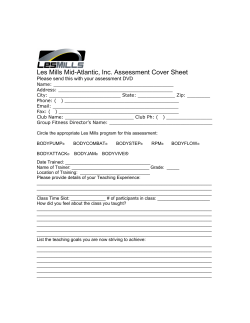
Workshop: Measuring Value
Workshop: Measuring Value Les Hems / Director, Climate Change and Sustainability Services, EY @leshems @ey_australia Simon Faivel / Director, Social Ventures Australia @Social_Ventures Mark Kramer / Co-founder & Managing Director, FSG @FSGtweets Measuring Shared Value Les Hems Director, EY Creating Shared Value Forum 14 April, 2015 Page 2 Agenda 1. How does measuring shared value differ to traditional measurement 2. A new approach for measuring value 3. Measuring value in practice: The Barossa Co-op Page 3 Shared value is an evolution Historical business conduct Sell more, deliver it cheaper and more efficiently Maximise value created from investment Minimise negative externalities on society Maximise economic and societal opportunities Acknowledge impact Industrial revolution 1990’s > Measure Financial Value Financial Reporting Address impacts of business Risks to opportunities 2010’s Measure Triple Bottom Line Measure impact Sustainability Reporting Measure Total Value Created Measure value Increasing voice of stakeholders eg customers, investors & communities driving change Page 4 Integrated Reporting Approaches to measuring performance, impact and value Industrial revolution Financial Value • Market Capitalisation • Debt to Cash Flow • Total intangibles to Total Assets • Leverage Ratio • Total Annual Investment Return • Profit Margin • Return on Equity • EBITDA • Future earnings Page 5 1990s 2010’s Triple Bottom Line Impact Total Value Created • Global Reporting Initiative • Social impact • Social audit • Environmental impact • London Benchmarking Group • Cost benefit analysis • Total Value Framework (EY) • Global Impact Investing Network (GIIN) • Total Contribution (nef) • Total Impact Measurement Impact (PwC) • True Value (KPMG) Organisations…. ‘create value beyond what is captured by financial statements’, hence there is a need to find new ways to demonstrate the total value created. EY – Elevating Value Report (2014) Page 6 Copyright © 2014 Ernst & Young Australia. All Rights Reserved. Liability limited by a scheme approved under Professional Standards Legislation Hierarchy of measuring shared value Enterprise • Measuring the shared value created to the core business strategy (for example, Nestle and Stockland) Business Unit Product/Service or Pilot Page 7 • Measuring shared value achieved at the business unit level (for example, Diageo, GSK, Pepsi and Walmart) • Measuring shared value from one product/ service or pilot project (for example, Cisco and Coca-‐Cola) Drivers for measuring value Corporates ► quantify the commercial return achieved from their community and sustainability investments ► quantify the social, environmental and broader economic value that is created by their core commercial activities ► identify how existing initiatives deliver on sustainability and corporate strategies. Not-for-profit ► systematically measure not only the social value they create but also the sustainability of this value creation and their role in local economies. Page 8 Before you can measure value you first need to identify… Key questions: 1. How does your organisation create value? 2. What is the type of value created? 3. Which stakeholders capture the value created? 4. What capitals does your organisation rely on to create value? The Total value Framework has 3 dimensions: Ø The 6 Capitals from Integrated Reporting: – financial, manufactured, intellectual, human, social and relationship, and natural Ø Stakeholders – producers, consumers and wider community Ø Time – short, medium and long term measurement Page 9 The EY Total Value Framework Business process used to create value Capital Inputs by Stakeholders MANUFACTURED Outcomes focus FINANCIAL FINANCIAL Materiality Transparency HUMAN HUMAN Plan & Design Implement Measure Report SOCIAL SOCIAL Stakeholder NATURAL Responsiveness inclusiveness INTELLECTUAL NATURAL INTELLECTUAL Toolbox Direct and Indirect Stakeholder outcomes Direct and Indirect Stakeholder inputs MANUFACTURED Page 10 Capital outcomes for Stakeholders Benefits of TVF 1. Improved understanding of how to create value and the different types of value created for different groups of stakeholders. 2. Gain insights into how they can improve the efficiency and effectiveness of their business to increase a particular type of value for particular groups of stakeholders. 3. Demonstrate their competitive advantage and social licence to grow. Page 11 ► Case Study: The Co-Op – Heart of the Barossa The Future Page 12 Complete Understand how you create value Page 13 Outcomes Page 14 Presentation title The total value created by The Co-op Foodland Page 15 Three steps for implementation Step 1: Develop outcomes measurement systems and use it as an internal learning process Step 2: When confident, demonstrate outcomes to key stakeholders Step 3. When confident, report outcomes to all stakeholders Start with a welldefined and understood program Share findings with clients, carers, family/guardians; investors and funders Focus on key outcome measures Benchmark across programs or with other providers Balance quantitative with qualitative Take colleagues step by step Make sure it is owned by everyone Page 16 Thank You ► Contact: ► Les Hems Director, EY Les.hems@au.ey.com ► ► Page 17
© Copyright 2025

















